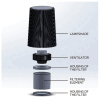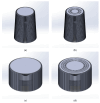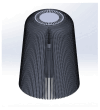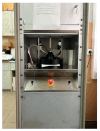Modeling the Geometry and Filter Composite of the Air Cleaner
- PMID: 39459674
- PMCID: PMC11509376
- DOI: 10.3390/ma17204969
Modeling the Geometry and Filter Composite of the Air Cleaner
Abstract
Air pollution is currently the most significant environmental factor posing a threat to the health and lives of European residents. It is a key cause of poor health, particularly respiratory and cardiovascular diseases. The primary aim of the study was to numerically determine the impact of the air purifier model's geometry on the distribution of air within a room and to conduct experimental tests on the filtration efficiency and preliminary antibacterial activity of filtration composites. The scope of the work included designing an air purifier model in the form of a pendant lamp and performing computer simulations in Ansys software to identify the optimal shape. The experimental research focused on developing filtration composites consisting of nonwoven fabric with an active hydrosol layer, meltblown nonwovens and a carbon filter. The study results showed that the SMMS composite with 50% thyme and carbon nonwoven exhibited the highest filtration efficiency for both small and large particles.
Keywords: air purifier; computer simulations; filter component; hydrosol.
Conflict of interest statement
The authors declare no conflict of interest.
Figures
















References
-
- Klepeis N.E., Nelson W.C., Ott W.R., Robinson J.P., Tsang A.M., Switzer P., Behar J.V., Hern S.C., Engelmann W.H. The National Human Activity Pattern Survey (NHAPS): A Resource for Assessing Exposure to Environmental Pollutants. J. Expo. Anal. Environ. Epidemiol. 2001;11:231–252. doi: 10.1038/sj.jea.7500165. - DOI - PubMed
-
- Sørensen S.B., Feilberg A., Kristensen K. Removal of Volatile Organic Compounds by Mobile Air Cleaners: Dynamics, Limitations, and Possible Side Effects. Build. Environ. 2023;242:110541. doi: 10.1016/j.buildenv.2023.110541. - DOI
Grants and funding
LinkOut - more resources
Full Text Sources
Molecular Biology Databases

